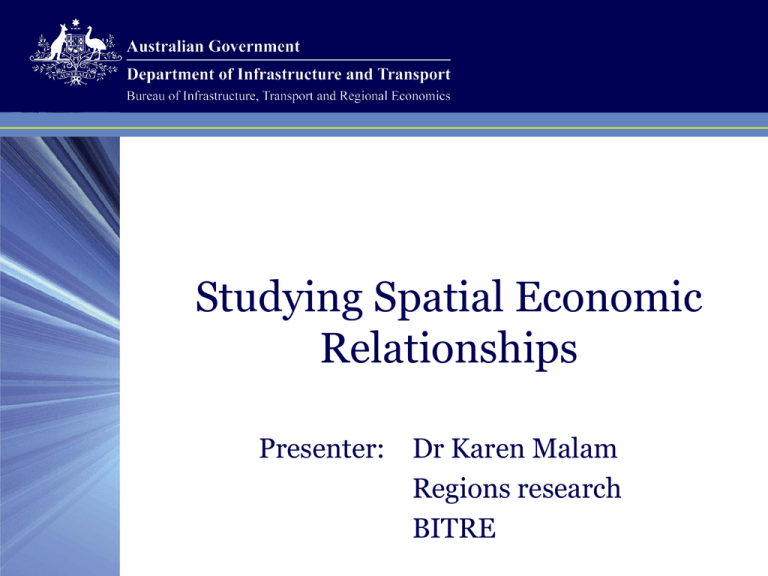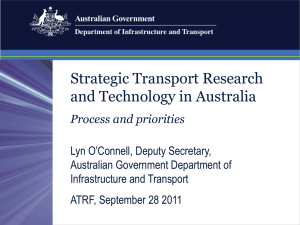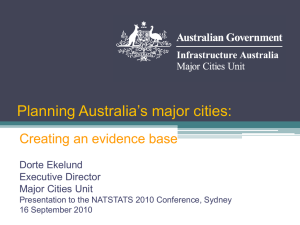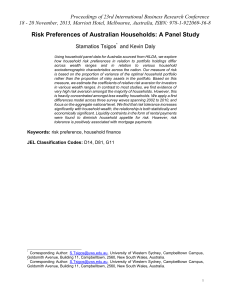Studying Spatial Economic Relationships Presenter: Dr Karen Malam Regions research
advertisement

Studying Spatial Economic Relationships Presenter: Dr Karen Malam Regions research BITRE Regional economies • Boundaries – Functional unit – Customised • Data – Small area estimation – Survey data 2 Industry Structure • Differences in regional industry structure plays a significant, but partial, role in explaining differences in regional economic growth. • A region's industry structure is closely tied to the size of its economy – but what is a regional economy? • Needed to develop working zone boundaries 3 Information paper 49 Working zones Local Government Areas • • 4 BITRE’s Working zones Labour market - economic functional area Based on commuting flows between Statistical Local Areas Map of Melbourne’s Working Zone Research report 125 5 Source: BITRE 2011a Commuting to Wyndham North SLA Source: BITRE 2011a 6 Melbourne 2030 activity centres Employment average annual growth rate, 2001 to 2006 2.50 Average annual growth rate (per cent) 2.00 1.50 1.00 0.50 0.00 -0.50 -1.00 7 BITRE 2011a Population movements Research report 122 8 BITRE 2011b Population movements, 2001 to 2006 9 Major Cities Unit, Department of Infrastructure and Transport 2011 Household Wealth • To improve understanding of household wealth & its relevance to regional wellbeing • To explore the relationship between regional wealth and regional income • To develop and analyse new measures of household wealth for Australia’s regions – 2003-04 snapshot 10 Information paper 63 Methodology • Small area estimation • ABS Survey of Income and Housing 2003-04 – Provides capital city/state balance benchmarks for each wealth component • Small area data sources: – – – – Valuer -General’s data on property sales ATO Taxation Statistics Census data Other ABS data • Estimates produced for 1135 Statistical Local Areas 11 Average household wealth, 2003-04 12 BITRE 2009 Comparison of wealth and income 13 BITRE 2009 Social Capital • Analyse the spatial dimensions of social capital in Australia. • Explore the extent to which social capital is related to particular aspects of the economic and social wellbeing of Australia’s regions. • Measure key elements of social capital at a regional scale. Information paper 55 14 Methodology • ABS Social Capital framework • Data sources – Household, Income and Labour Dynamics in Australia (HILDA) – ABS General Social Survey • Boundaries – Capital cities and Balance of state – Remoteness classification – 69 BITRE defined regions • 33 Social Capital indicators 15 Examples of indicators Network qualities • Feeling of safety at home after dark 16 Network structure • Frequency of social contact • Neighbours helping each other out • Volunteering rate • Active membership • Labour force participation rate • Usage of email or chat sites in the last 12 months • Proportion who live in the same SLA as they did 5 years ago Network transactions • Could ask someone for a favour Network types • I often feel very lonely • Capacity to raise $2000 in a week for emergency • Integration into the community • Only get together socially once a months or less with friends or relatives BITRE 2005 Community involvement 17 BITRE 2005 Concluding remarks • Regional economies • Boundaries – – – – Administrative ABS – Mesh blocks Functional area Customised area • Availability of data – Wide variety of sources (sometimes of varying quality). – Development of new datasets – Confidentiality and small sample size 18 Karen Malam BITRE Regional Research karen.malam@infrastructure.gov.au <www.bitre.gov.au>







